Roughly a decade ago I read an article that asked antivirus vendors to stop intercepting encrypted HTTPS connections, this practice actively hurting security and privacy. As you can certainly imagine, antivirus vendors agreed with the sensible argument and today no reasonable antivirus product would even consider intercepting HTTPS traffic. Just kidding… Of course they kept going, and so two years ago a study was published detailing the security issues introduced by interception of HTTPS connections. Google and Mozilla once again urged antivirus vendors to stop. Surely this time it worked?
Of course not. So when I decided to look into Kaspersky Internet Security in December last year, I found it breaking up HTTPS connections so that it would get between the server and your browser in order to “protect” you. Expecting some deeply technical details about HTTPS protocol misimplementations now? Don’t worry, I don’t know enough myself to inspect Kaspersky software on this level. The vulnerabilities I found were far more mundane.
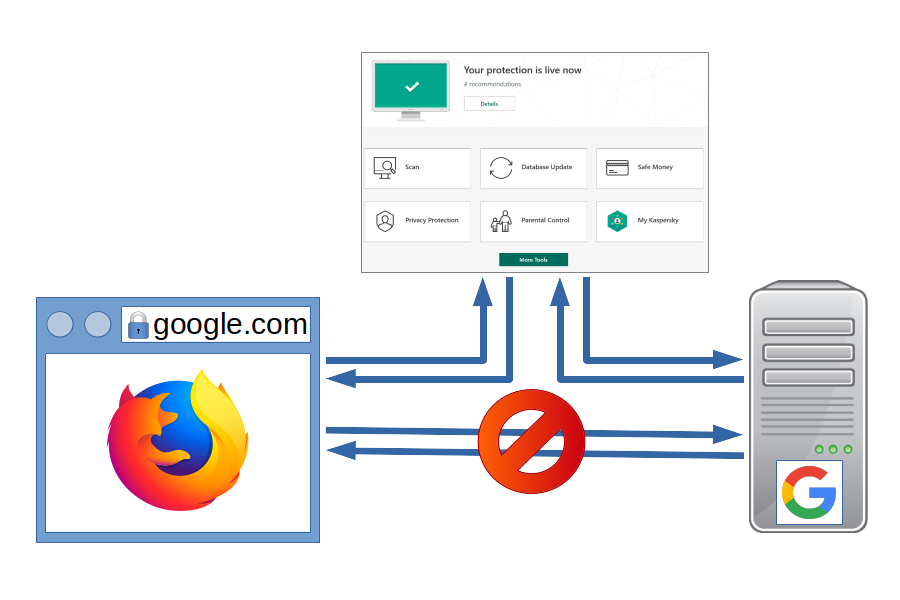
I reported eight vulnerabilities to Kaspersky Lab between 2018-12-13 and 2018-12-21. This article will only describe three vulnerabilities which have been fixed in April this year. This includes two vulnerabilities that weren’t deemed a security risk by Kaspersky, it’s up to you to decide whether you agree with this assessment. The remaining five vulnerabilities have only been fixed in July, and I agreed to wait until November with the disclosure to give users enough time to upgrade.
Edit (2019-08-22): In order to disable this functionality you have to go into Settings, select “Additional” on the left side, then click “Network.” There you will see a section called “Encryption connection scanning” where you need to choose “Do not scan encrypted connections.”
Contents
The underappreciated certificate warning pages
There is an important edge case with HTTPS connections: what if a connection is established but the other side uses an invalid certificate? Current browsers will generally show you a certificate warning page in this scenario. In Firefox it looks like this:
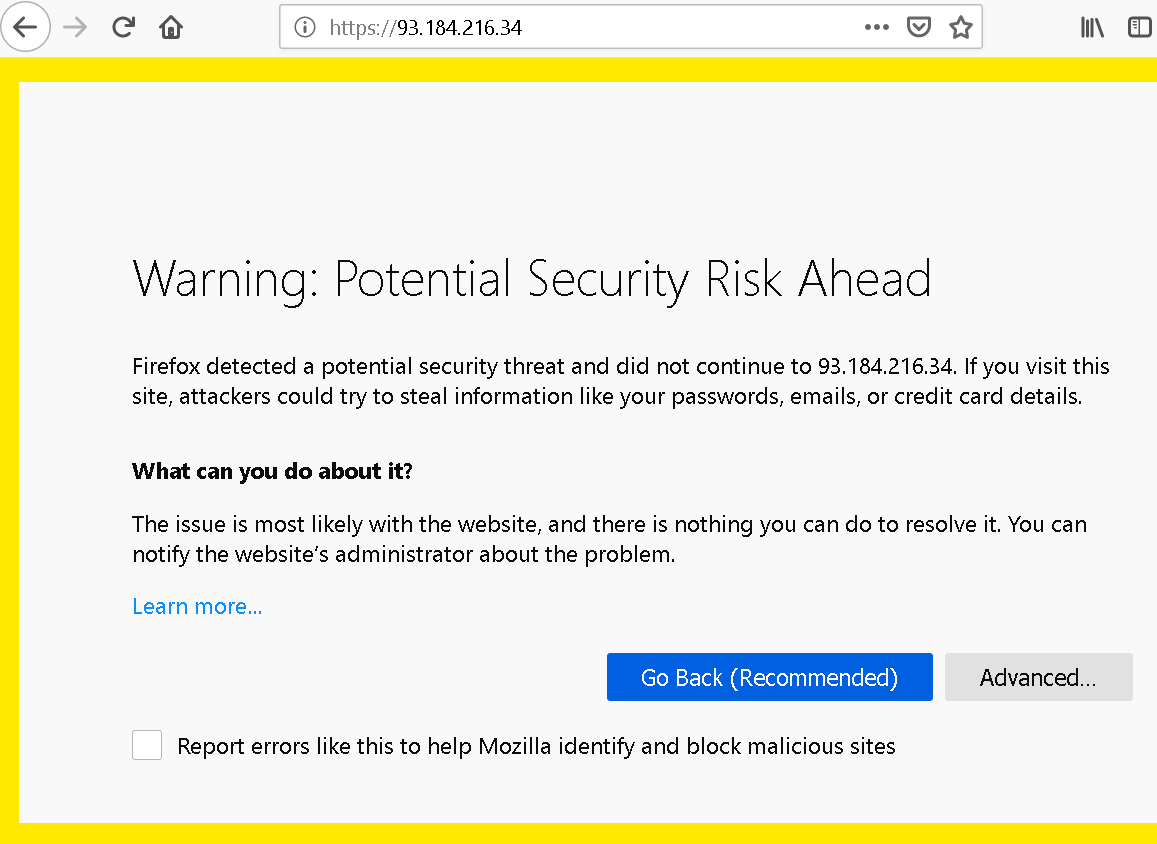
This page has seen a surprising amount of changes over the years. The browser vendors recognized that asking users to make a decision isn’t a good idea here. Most of the time, getting out is the best course of action, and ignoring the warning only a viable option for very technical users. So the text here is very clear, low on technical details, and the recommended solution is highlighted. The option to ignore the warning is well-hidden on the other hand, to prevent people from using it without understanding the implications. While the page looks different in other browsers, the main design considerations are the same.
But with Kaspersky Internet Security in the middle, the browser is no longer talking to the server, Kaspersky is. The way HTTPS is designed, it means that Kaspersky is responsible for validating the server’s certificate and producing a certificate warning page. And that’s what the certificate warning page looks like then:
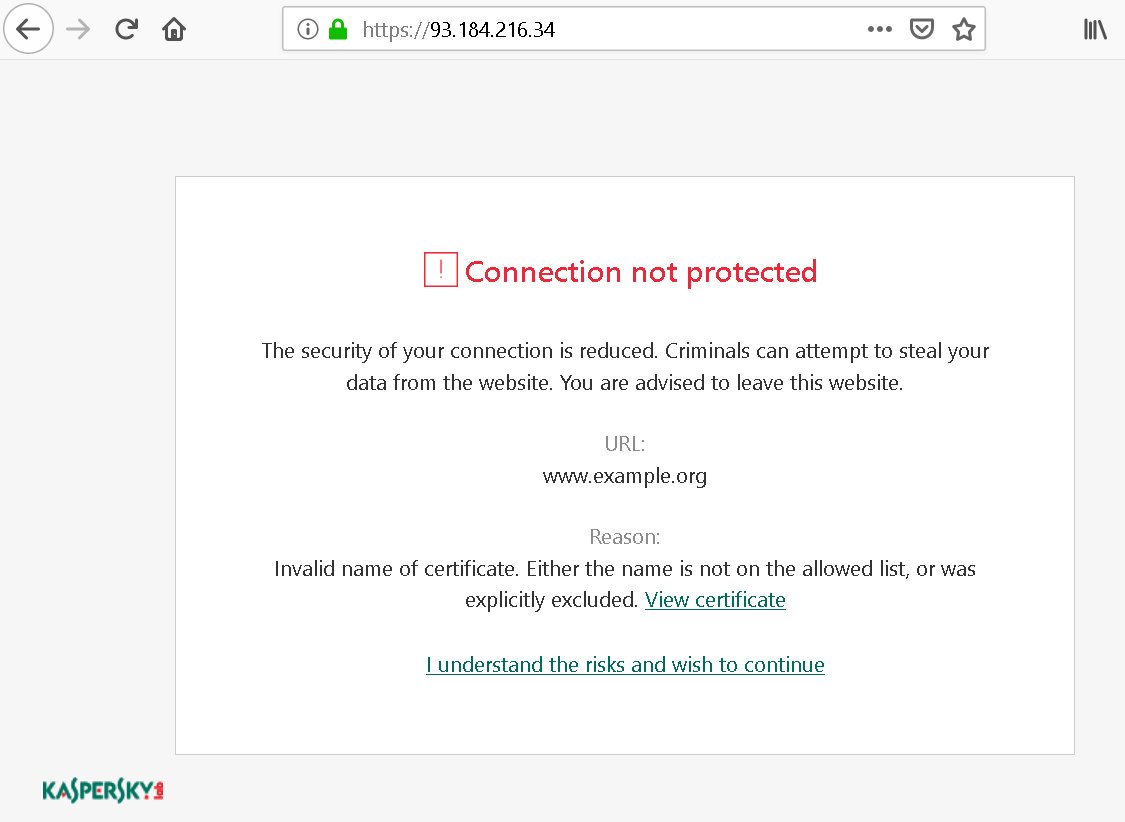
There is a considerable amount of technical details here, supposedly to allow users to make an informed decision, but usually confusing them instead. Oh, and why does it list the URL as “www.example.org”? That’s not what I typed into the address bar, it’s actually what this site claims to be (the name has been extracted from the site’s invalid certificate). That’s a tiny security issue here, wasn’t worth reporting however as this only affects sites accessed by IP address which should never be the case with HTTPS.
The bigger issue: what is the user supposed to do here? There is “leave this website” in the text, but experience shows that people usually won’t read when hitting a roadblock like this. And the highlighted action here is “I understand the risks and wish to continue” which is what most users can be expected to hit.
Using clickjacking to override certificate warnings
Let’s say that we hijacked some user’s web traffic, e.g. by tricking them into connecting to our malicious WiFi hotspot. Now we want to do something evil with that, such as collecting their Google searches or hijacking their Google account. Unfortunately, HTTPS won’t let us do it. If we place ourselves between the user and the Google server, we have to use our own certificate for the connection to the user. With our certificate being invalid, this will trigger a certificate warning however.
So the goal is to make the user click “I understand the risks and wish to continue” on the certificate warning page. We could just ask nicely, and given how this page is built we’ll probably succeed in a fair share of cases. Or we could use a trick called clickjacking – let the user click it without realizing what they are clicking.
There is only one complication. When the link is clicked there will be an additional confirmation pop-up:
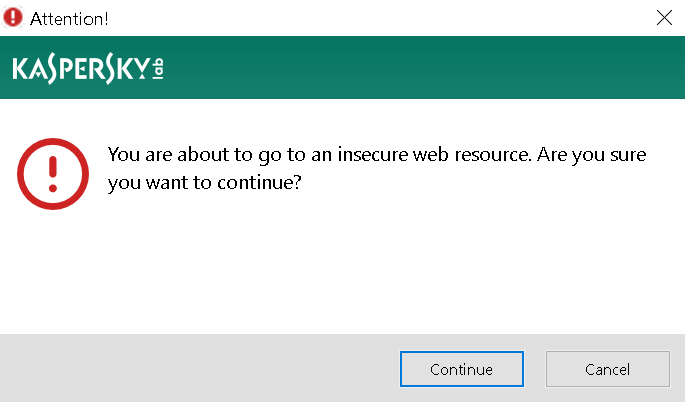
But don’t despair just yet! That warning is merely generic text, it would apply to any remotely insecure action. We would only need to convince the user that the warning is expected and they will happily click “Continue.” For example, we could give them the following page when they first connect to the network, similar to those captive portals:
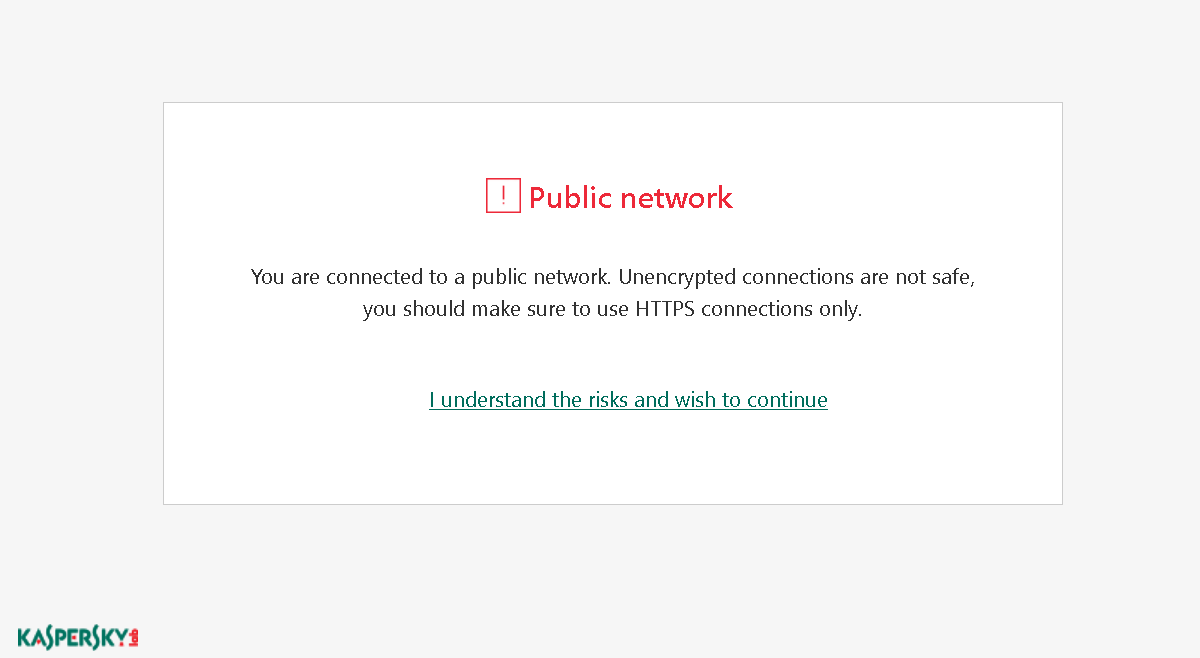
Looks like a legitimate Kaspersky warning page but isn’t, the text here was written by me. The only “real” thing here is the “I understand the risks and wish to continue” link which actually belongs to an embedded frame. That frame contains Kaspersky’s certificate warning for www.google.com and has been positioned in such a way that only the link is visible. When the user clicks it, they will get the generic warning from above and without doubt confirm ignoring the invalid certificate. We won, now we can do our evil thing without triggering any warnings!
How browser vendors deal with this kind of attack? They require at least two clicks to happen on different spots of the certificate warning page in order to add an exception for an invalid certificate, this makes clickjacking attacks impracticable. Kaspersky on the other hand felt very confident about their warning prompt, so they opted for adding more information to it. This message will now show you the name of the site you are adding the exception for. Let’s just hope that accessing a site by IP address is the only scenario where attackers can manipulate that name…
Something you probably don’t know about HSTS
There is a slightly less obvious detail to the attack described above: it shouldn’t have worked at all. See, if you reroute www.google.com traffic to a malicious server and navigate to the site then, neither Firefox nor Chrome will give you the option to override the certificate warning. Getting out will be the only option available, meaning no way whatsoever to exploit the certificate warning page. What is this magic? Did browsers implement some special behavior only for Google?
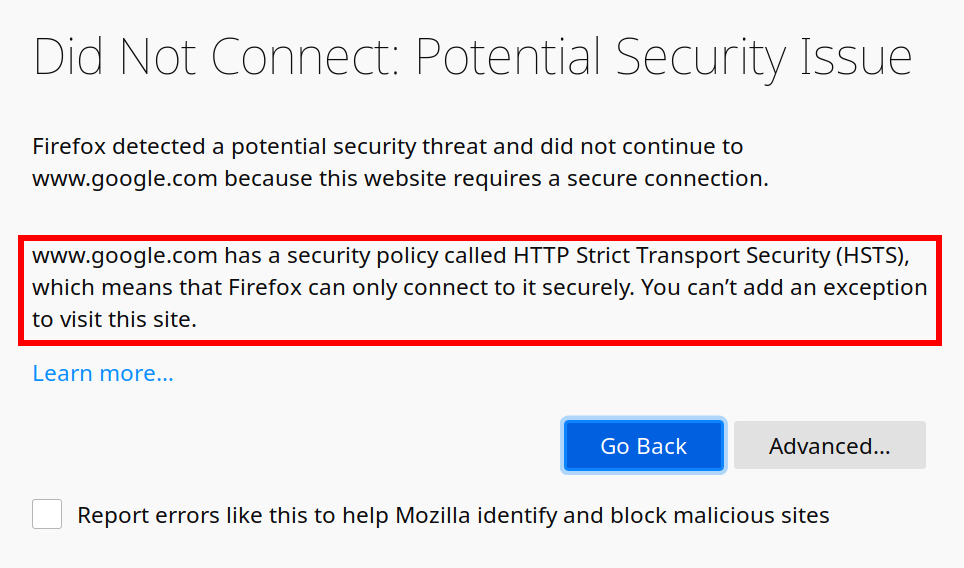
They didn’t. What you see here is a side-effect of the HTTP Strict-Transport-Security (HSTS) mechanism, which Google and many other websites happen to use. When you visit Google it will send the HTTP header Strict-Transport-Security: max-age=31536000 with the response. This tells the browser: “This is an HTTPS-only website, don’t ever try to create an unencrypted connection to it. Keep that in mind for the next year.”
So when the browser later encounters a certificate error on a site using HSTS, it knows: the website owner promised to keep HTTPS functional. There is no way that an invalid certificate is ok here, so allowing users to override the certificate would be wrong.
Unless you have Kaspersky in the middle of course, because Kaspersky completely ignores HSTS and still allows users to override the certificate. When I reported this issue, the vendor response was that this isn’t a security risk because the warning displayed is sufficient. Somehow they decided to add support for HSTS nevertheless, so that current versions will no longer allow overriding certificates here.
It’s no doubt that there are more scenarios where Kaspersky software weakens the security precautions made by browsers. For example, if a certificate is revoked (usually because it has been compromised), browsers will normally recognize that thanks to OCSP stapling and prevent the connection. But I noticed recently that Kaspersky Internet Security doesn’t support OCSP stapling, so if this application is active it will happily allow you to connect to a likely malicious server.
Using injected content for Universal XSS
Kaspersky Internet Security isn’t merely listening in on connections to HTTPS sites, it is also actively modifying those. In some cases it will generate a response of its own, such as the certificate warning page we saw above. In others it will modify the response sent by the server.
For example, if you didn’t install the Kaspersky browser extension, it will fall back to injecting a script into server responses which is then responsible for “protecting” you. This protection does things like showing a green checkmark next to Google search results that are considered safe. As Heise Online wrote merely a few days ago, this also used to leak a unique user ID which allowed tracking users regardless of any protective measures on their side. Oops…
There is a bit more to this feature called URL Advisor. When you put the mouse cursor above the checkmark icon a message appears stating that you have a safe site there. That message is a frame displaying url_advisor_balloon.html. Where does this file load from? If you have the Kaspersky browser extension, it will be part of that browser extension. If you don’t, it will load from ff.kis.v2.scr.kaspersky-labs.com in Firefox and gc.kis.v2.scr.kaspersky-labs.com in Chrome – Kaspersky software will intercept requests to these servers and answer them locally. I noticed however that things were different in Microsoft Edge, here this file would load directly from www.google.com (or any other website if you changed the host name).
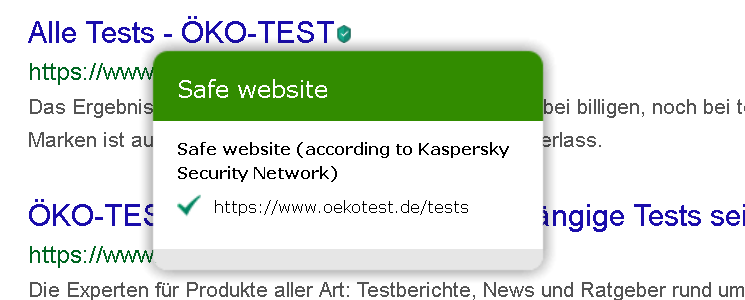
Certainly, when injecting their own web page into every domain on the web Kaspersky developers thought about making it very secure? Let’s have a look at the code running there:
var policeLink = document.createElement("a");
policeLink.href = IsDefined(UrlAdvisorLinkPoliceDecision) ? UrlAdvisorLinkPoliceDecision : locales["UrlAdvisorLinkPoliceDecision"];
policeLink.target = "_blank";
div.appendChild(policeLink);This creates a link inside the frame dynamically. Where the link target comes from? It’s part of the data received from the parent document, no validation performed. In particular, javascript: links will be happily accepted. So a malicious website needs to figure out the location of url_advisor_balloon.html and embed it in a frame using the host name of the website they want to attack. Then they send a message to it:
frame.contentWindow.postMessage(JSON.stringify({
command: "init",
data: {
verdict: {
url: "",
categories: [
21
]
},
locales: {
UrlAdvisorLinkPoliceDecision: "javascript:alert('Hi, this JavaScript code is running on ' + document.domain)",
CAT_21: "click here"
}
}
}), "*");What you get is a link labeled “click here” which will run arbitrary JavaScript code in the context of the attacked domain when clicked. And once again, the attackers could ask the user nicely to click it. Or they could use clickjacking, so whenever the user clicks anywhere on their site, the click goes to this link inside an invisible frame.
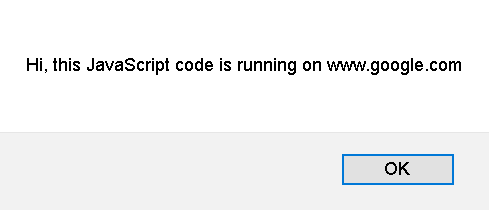
And here you have it: a malicious website taking over your Google or social media accounts, all because Kaspersky considered it a good idea to have their content injected into secure traffic of other people’s domains. But at least this particular issue was limited to Microsoft Edge.
Timeline
- 2018-12-13: Sent report via Kaspersky bug bounty program: Lack of HSTS support facilitating MiTM attacks.
- 2018-12-17: Sent reports via Kaspersky bug bounty program: Certificate warning pages susceptible to clickjacking and Universal XSS in Microsoft Edge.
- 2018-12-20: Response from Kaspersky: HSTS and clickjacking reports are not considered security issues.
- 2018-12-20: Requested disclosure of the HSTS and clickjacking reports.
- 2018-12-24: Disclosure denied due to similarity with one of my other reports.
- 2019-04-29: Kaspersky notifies me about the three issues here being fixed (KIS 2019 Patch E, actually released three weeks earlier).
- 2019-04-29: Requested disclosure of these three issues, no response.
- 2019-07-29: With five remaining issues reported by me fixed (KIS 2019 Patch F and KIS 2020), requested disclosure on all reports.
- 2019-08-04: Disclosure denied on HSTS report because “You’ve requested too many tickets for disclosure at the same time.”
- 2019-08-05: Disclosure denied on five not yet disclosed reports, asking for time until November for users to update.
- 2019-08-06: Notified Kaspersky about my intention to publish an article about the three issues here on 2019-08-19, no response.
- 2019-08-12: Reminded Kaspersky that I will publish an article on these three issues on 2019-08-19.
- 2019-08-12: Kaspersky requesting an extension of the timeline until 2019-08-22, citing that they need more time to prepare.
- 2019-08-16: Security advisory published by Kaspersky without notifying me.
Comments
Would setting a custom dns server in the browser cause the request to contain IP instead of domain since it has already been resolved? I don't know how antivirus intercepts the requests, but if its via the OS, removing the OS's responsibility of resolving the domain could make it look like the the user types the IP manually.
No, that wouldn't help. If anything, you would need to use a proxy server. But Kaspersky would probably get into the connection even there.
Note that I would expect disabling Web Anti-Virus, Private Browsing and Anti-Banner features to disable this functionality. But I can still see Kaspersky intercepting the connection.
Great post. AVs need to die. Very minor nitpick:
That's not true. Here's a real world example: https://1.1.1.1/
What the... How did they get a valid certificate for an IP address? Is that even allowed?
Wladimir Palant: with the Subject Alternative Name option. Inspect the cert attributes to see it :)
It doesn't matter where it is, the validation requirements are the same. But, apparently, getting a certificate for an IP address is allowed: https://stackoverflow.com/a/37063612/785541
Well, always learning something new...
Good findings, thanks!
I was wondering about the timeline: kaspersky seems to have tried to shaft you with the disclosure. Is there a reason you haven't given them a deadline for when you'll disclose these bugs? I guess that by submitting to their bounty program, you forfeit these rights for some (potential?) monetary compensation? Would you submit bugs to that program again, or choose a more google-project-zero-style way next time?
I'm not involved in the bug bounty scene, so I'm sorry if this question is trivial.
Yes, when going through the bug bounty program you have to agree to the terms. Here, that includes not disclosing bugs until they are fixed - and it's up to the vendor how long it takes. I didn't feel that this was important enough to push the matter for reports that they didn't consider a security risk. But the constant excuses got me pissed in the end, which is why I won't be reporting bugs via their bug bounty program again. I sent them three issue reports again today, based on not quite closed earlier reports - deadline is November 25th. No monetary reward in that case of course.
Yeap. For Subject Alt Name you can use either DNS:<hostname> or IP:<ip.address>.
So basically this wright up(Except Injected Content in Edge) is about you disagreeing with Kaspersky's one click user https trust confirmation Police? I get that, but do not necessarily agree with you. "Normal" users as you state many times, will not be often exposed to invalid Certificates unless they are somehow extensively exploring the Web. No matter the way you present the warning, it is up to the user to decide the action. In my opinion the One Click policy is enough for warning the users, but I understand the point in having two click strategies.
Have you tried to disable HTTPS inspection? This stops the agent from intercepting traffic.....
And come on dude, what is up with that negative attitude towards Client Security Vendors? You have to remember that not everyone has the same technical knowledge and skillset to protect themselves proactively. Client Security is needed to protect against generic threats and malware for Billions of users who has other skills than IT & Security.
Great work on the EDGE Injected Content. Hopefully disclosure is rewarded with their Bug Bounty program.
You seem to be misunderstanding the issue. It's not about you surfing the web and encountering a server where the owner somehow didn't manage to get a valid certificate or forgot to renew it or whatever. It's rather the scenario that HTTPS is supposed to protect you against: it's not the right server at all, merely somebody posing as it. Which could be the case e.g. if you are connected to a malicious or compromised network (open WiFi being a typical scenario where you cannot trust the network), or if state-level actor wants to see contents of your communication (see Kazakhstan in the news just recently). These are scenarios where an easy to override warning is not enough, because ignoring the warning will result in really bad things happening. Besides, in the clickjacking scenario the user wouldn't even see the warning - merely a page with whatever "explanation" attackers can come up with.
Where does one disable HTTPS inspection in Kaspersky Internet Security? I can disable "Inject script into web traffic" and I can disable "Web Anti-Virus" -- neither of these has the desired effect. If you check the certificate for any website in the browser, you will still see it being signed by Kaspersky.
Yes, I received $2,500 bug bounty for the Universal XSS vulnerability, thank you.
Any user & company have sensitive information and have good knowledge about Security, only use Antvirus & Security Services from most trusty & valid Security companies.
NO kaspersky
So which ones would you consider "trusty & valid"? There are plenty of other antivirus vendors breaking up HTTPS connections - see the first link in this article. I still have to take a look at those but I doubt that they've done a significantly better job. The antivirus industry is generally broken, plenty of articles on the wrong incentives here.
If you really want a conclusion: if you are on Windows 10, use Windows Defender. Do not install a third-party antivirus, it won't make you any more secure (often the opposite).
I think you have not good information about Records kaspersky.
issue lie news & Article.
Tens of thousands of dollars of scams from partners and resellers & customers.
& Ignoring security flaws
I trace their record for more than 12 years .
Thanks ,
Amir Safari Foroshani
Security software Market Analyzer
i visit first link, thank you
when i talk about most valid and trusty security companies, i means some companies same Symantec , Trend micro, McAfee , Webroot
Thank you very much for your detailed description of this issue. I found your arcticle during my research, if the internet security functions regarding browsing of different security vendors are making things better or worse. In terms of installing a middle man, I think your article shows quite clear, that it makes things worse. But I'm still wondering, if there is a benefit at all with actual / modern browsers like Firefox, Chrome and edge. The vendors of security software clame that they protect you against malicious websites, malware, pishing sites, websites containing Adware and so on. But do they really deliver a benefit above the built in functions of the modern browsers. Without being able to dive into this personally, I think they just do the same as modern browser do anyway but obviously in some cases even less secure (e.g. no OCSP stapling). I installed Kaspersky Anti Virus 2020 for evaluation. I chose the Anti Virus and not a suite (IS / TS) because I just wanted the basic features of an Anti Virus software on a Windows 8.1 machine. (I think under Win 8.1 the windows defender isn't sufficient.) But by default Kaspersky AV comes with Web-Anti-Virus and automatic browser implementation. Would you suggest to deactivate Web-Anti-Virus at all or do you still see any benefit of that tool in conjunction with modern Browsers? Did I understand your article correctly, that you at least have to disable "Encryption connection scanning" AND "include scripting in datatraffic while interacting with websites". Thank you very much for your reply!
I have been asking myself the same question. Antivirus vendors compete with built-in phishing and malware protection of the browsers which is usually based on Google Safe Browsing these days (Microsoft and Apple browsers being the notable exceptions). I have no idea how one would even approach validating the claims by antivirus vendors that they offer better protection here. There is also a typical weak point in their solution: they cannot check synchronously whether a website is malicious, so they allow it to load and will replace it after the fact. See also my research on the McAfee SiteAdvisor extension (more to be published here later).
The other protection component is typically vetting of search results. Here they are competing with Google's and Bing's efforts to keep malicious websites out of the search index. Yet again, I have no idea on how an independent validation of the effectiveness would work.
Given how these "web antivirus" features are often flawed and how it is almost impossible to prove an effect, I'm inclined to recommend staying away from them. And - yes, it's definitely a good idea to disable these two settings in Kaspersky software.